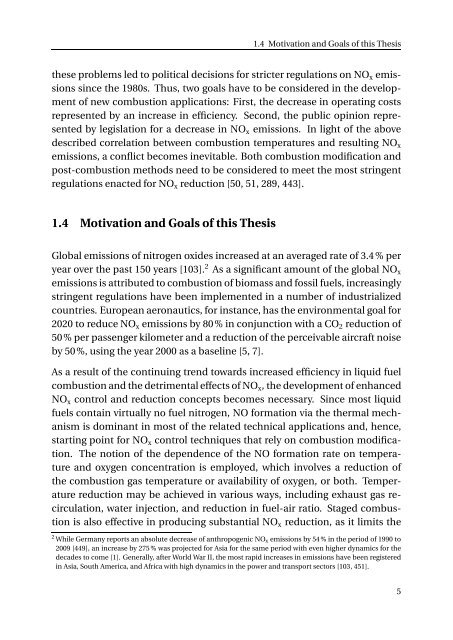On the Formation of Nitrogen Oxides During the Combustion of ...
On the Formation of Nitrogen Oxides During the Combustion of ...
On the Formation of Nitrogen Oxides During the Combustion of ...
You also want an ePaper? Increase the reach of your titles
YUMPU automatically turns print PDFs into web optimized ePapers that Google loves.
1.4 Motivation and Goals <strong>of</strong> this Thesis<br />
<strong>the</strong>se problems led to political decisions for stricter regulations on NO x emissions<br />
since <strong>the</strong> 1980s. Thus, two goals have to be considered in <strong>the</strong> development<br />
<strong>of</strong> new combustion applications: First, <strong>the</strong> decrease in operating costs<br />
represented by an increase in efficiency. Second, <strong>the</strong> public opinion represented<br />
by legislation for a decrease in NO x emissions. In light <strong>of</strong> <strong>the</strong> above<br />
described correlation between combustion temperatures and resulting NO x<br />
emissions, a conflict becomes inevitable. Both combustion modification and<br />
post-combustion methods need to be considered to meet <strong>the</strong> most stringent<br />
regulations enacted for NO x reduction [50, 51, 289, 443].<br />
1.4 Motivation and Goals <strong>of</strong> this Thesis<br />
Global emissions <strong>of</strong> nitrogen oxides increased at an averaged rate <strong>of</strong> 3.4 % per<br />
year over <strong>the</strong> past 150 years [103]. 2 As a significant amount <strong>of</strong> <strong>the</strong> global NO x<br />
emissions is attributed to combustion <strong>of</strong> biomass and fossil fuels, increasingly<br />
stringent regulations have been implemented in a number <strong>of</strong> industrialized<br />
countries. European aeronautics, for instance, has <strong>the</strong> environmental goal for<br />
2020 to reduce NO x emissions by 80% in conjunction with a CO 2 reduction <strong>of</strong><br />
50% per passenger kilometer and a reduction <strong>of</strong> <strong>the</strong> perceivable aircraft noise<br />
by 50%, using <strong>the</strong> year 2000 as a baseline [5, 7].<br />
As a result <strong>of</strong> <strong>the</strong> continuing trend towards increased efficiency in liquid fuel<br />
combustion and <strong>the</strong> detrimental effects <strong>of</strong> NO x , <strong>the</strong> development <strong>of</strong> enhanced<br />
NO x control and reduction concepts becomes necessary. Since most liquid<br />
fuels contain virtually no fuel nitrogen, NO formation via <strong>the</strong> <strong>the</strong>rmal mechanism<br />
is dominant in most <strong>of</strong> <strong>the</strong> related technical applications and, hence,<br />
starting point for NO x control techniques that rely on combustion modification.<br />
The notion <strong>of</strong> <strong>the</strong> dependence <strong>of</strong> <strong>the</strong> NO formation rate on temperature<br />
and oxygen concentration is employed, which involves a reduction <strong>of</strong><br />
<strong>the</strong> combustion gas temperature or availability <strong>of</strong> oxygen, or both. Temperature<br />
reduction may be achieved in various ways, including exhaust gas recirculation,<br />
water injection, and reduction in fuel-air ratio. Staged combustion<br />
is also effective in producing substantial NO x reduction, as it limits <strong>the</strong><br />
2 While Germany reports an absolute decrease <strong>of</strong> anthropogenic NO x emissions by 54% in <strong>the</strong> period <strong>of</strong> 1990 to<br />
2009 [449], an increase by 275 % was projected for Asia for <strong>the</strong> same period with even higher dynamics for <strong>the</strong><br />
decades to come [1]. Generally, after World War II, <strong>the</strong> most rapid increases in emissions have been registered<br />
in Asia, South America, and Africa with high dynamics in <strong>the</strong> power and transport sectors [103, 451].<br />
5
















